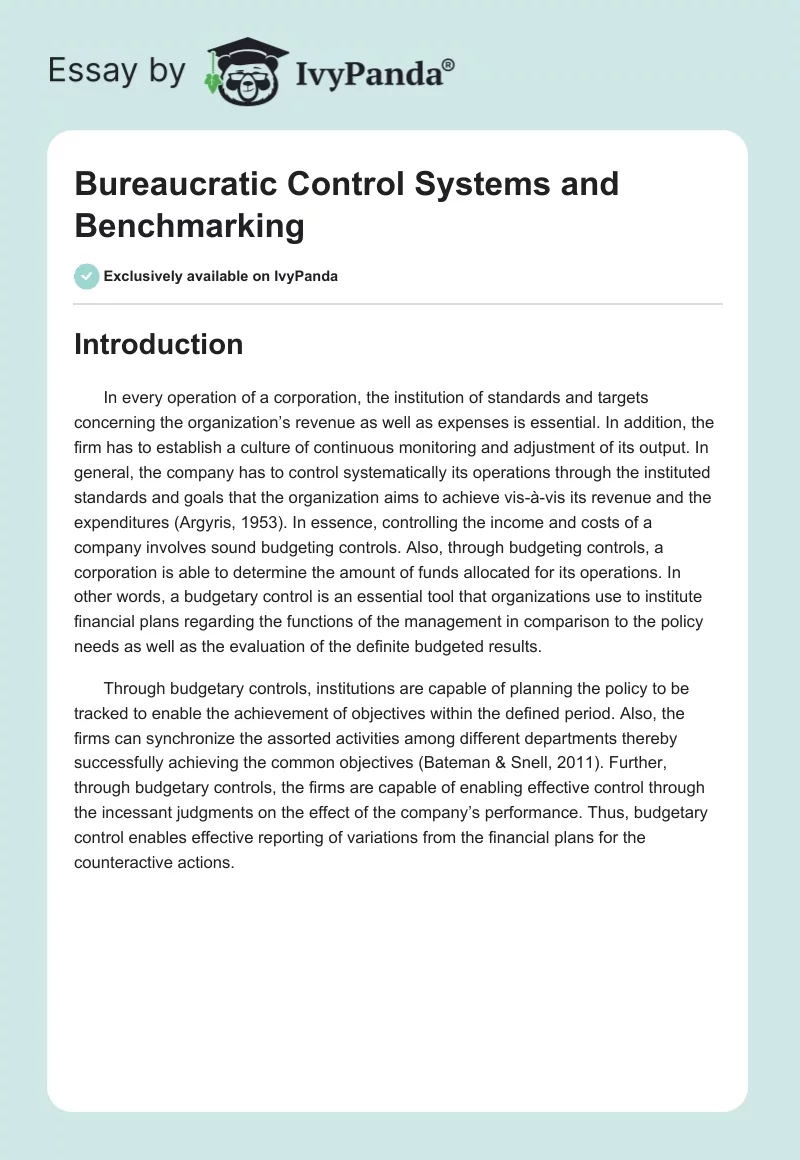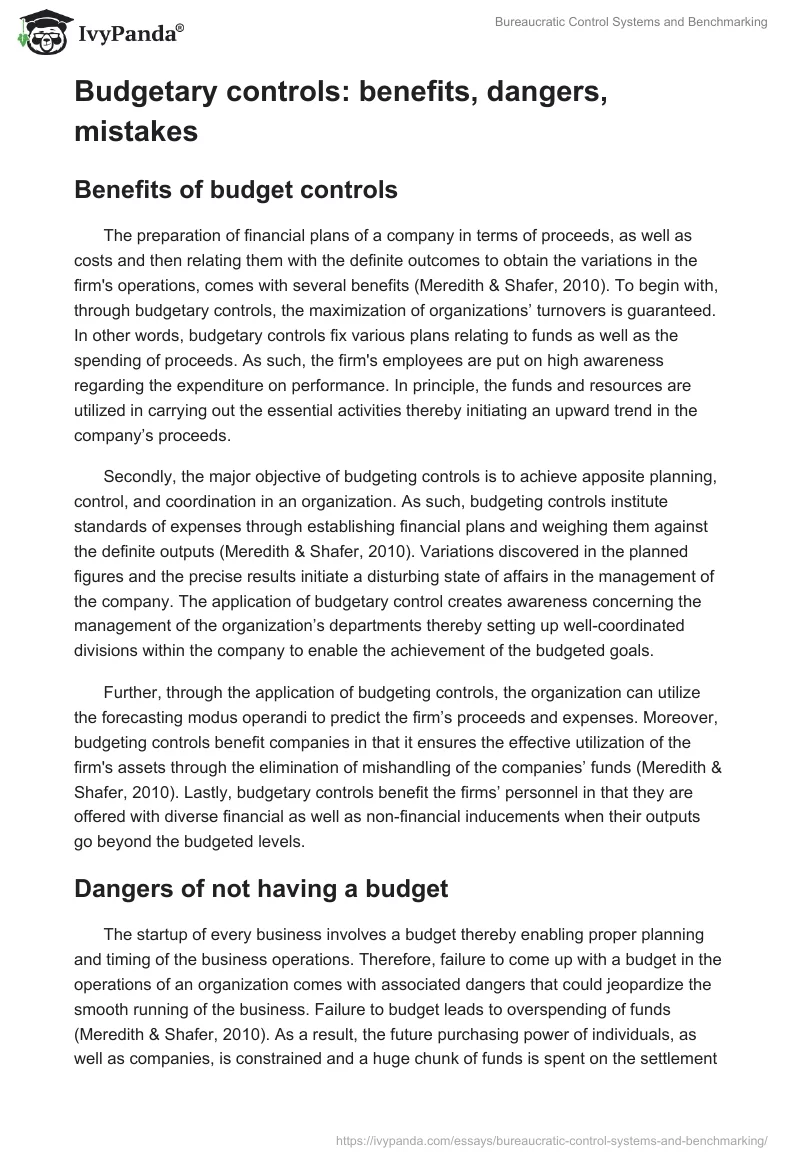Introduction
In every operation of a corporation, the institution of standards and targets concerning the organization’s revenue as well as expenses is essential. In addition, the firm has to establish a culture of continuous monitoring and adjustment of its output. In general, the company has to control systematically its operations through the instituted standards and goals that the organization aims to achieve vis-à-vis its revenue and the expenditures (Argyris, 1953). In essence, controlling the income and costs of a company involves sound budgeting controls. Also, through budgeting controls, a corporation is able to determine the amount of funds allocated for its operations. In other words, a budgetary control is an essential tool that organizations use to institute financial plans regarding the functions of the management in comparison to the policy needs as well as the evaluation of the definite budgeted results.
Through budgetary controls, institutions are capable of planning the policy to be tracked to enable the achievement of objectives within the defined period. Also, the firms can synchronize the assorted activities among different departments thereby successfully achieving the common objectives (Bateman & Snell, 2011). Further, through budgetary controls, the firms are capable of enabling effective control through the incessant judgments on the effect of the company’s performance. Thus, budgetary control enables effective reporting of variations from the financial plans for the counteractive actions.
Budgetary controls: benefits, dangers, mistakes
Benefits of budget controls
The preparation of financial plans of a company in terms of proceeds, as well as costs and then relating them with the definite outcomes to obtain the variations in the firm’s operations, comes with several benefits (Meredith & Shafer, 2010). To begin with, through budgetary controls, the maximization of organizations’ turnovers is guaranteed. In other words, budgetary controls fix various plans relating to funds as well as the spending of proceeds. As such, the firm’s employees are put on high awareness regarding the expenditure on performance. In principle, the funds and resources are utilized in carrying out the essential activities thereby initiating an upward trend in the company’s proceeds.
Secondly, the major objective of budgeting controls is to achieve apposite planning, control, and coordination in an organization. As such, budgeting controls institute standards of expenses through establishing financial plans and weighing them against the definite outputs (Meredith & Shafer, 2010). Variations discovered in the planned figures and the precise results initiate a disturbing state of affairs in the management of the company. The application of budgetary control creates awareness concerning the management of the organization’s departments thereby setting up well-coordinated divisions within the company to enable the achievement of the budgeted goals.
Further, through the application of budgeting controls, the organization can utilize the forecasting modus operandi to predict the firm’s proceeds and expenses. Moreover, budgeting controls benefit companies in that it ensures the effective utilization of the firm’s assets through the elimination of mishandling of the companies’ funds (Meredith & Shafer, 2010). Lastly, budgetary controls benefit the firms’ personnel in that they are offered with diverse financial as well as non-financial inducements when their outputs go beyond the budgeted levels.
Dangers of not having a budget
The startup of every business involves a budget thereby enabling proper planning and timing of the business operations. Therefore, failure to come up with a budget in the operations of an organization comes with associated dangers that could jeopardize the smooth running of the business. Failure to budget leads to overspending of funds (Meredith & Shafer, 2010). As a result, the future purchasing power of individuals, as well as companies, is constrained and a huge chunk of funds is spent on the settlement of debts. Also, failure to budget leads to a lack of saving money for future investment purposes. In essence, through budgeting, individuals are able to assign the funds towards certain programs hence, they can save and invest their income on various projects. However, the failure to have a budget deprives individuals of the financial freedom to invest in different projects in the future.
Without a budget, corporations, as well as individuals, are unable to plan and set the personal and financial objectives efficiently. A lack of clear financial plans robs individuals and corporations apparent insights of initiating pragmatic arrangements with the available funds (Meredith & Shafer, 2010). Further, lack of budgeting leads to the inability of the company to numerical forecast of its plans. Moreover, failure to budget jeopardizes the ability of an organization to achieve effective coordination of interconnected activities of the firm. Failure to budget leads to deficiency in specialization among the company’s employees thereby leading to inefficiency.
Common mistakes in budgeting
Several common mistakes occur in budgeting leading to unrealistic financial plans. To begin with, failure to set aside a lump sum of the overall budget that caters for contingencies such as fire and floods is always common. Also, setting inflexible budgets make it difficult for savings as well as limiting the firm’s ability to sustain a precise financial outlook. Failure to track the company’s proceeds and expenditures regularly contributes to the inability to make mindful decisions concerning the firm’s expenditure (Meredith & Shafer, 2010). Overstatement of projection within the budgets offers big promises that fail to last and deliver the goals of the organization. Another common mistake in budgeting involves inattention to the pressing budgetary needs and pursuing projects that will not succeed without more funding.
Benchmarking as a control in the Wal-Mart company, its benefits and weaknesses
The concept of benchmarking as a control in Wal-Mart Incorporation
The performance and the quality of services of the Wal-Mart Company use a set of standards drawn from the firm’s own experience as well as the experience of other firms in the industry. Further, legal specifications also form part of Wal-Mart’s benchmark. Moreover, owing to the ever-changing and technologically sophisticated corporate environment, Wal-Mart Company continues to come up with innovative procedures aimed at enabling superior inventory control.
Currently, several corporations continue to employ the concepts of material requirements planning (MRP) and just-in-time (JIT) management styles in their operations (Ammons, 1999). However, Wal-Mart Incorporation together with Warner-Lambert Company has initiated a collaborative forecasting and replenishment (CFAR) piloting project that carries massive advantages. For instance, the project through the dynamic collaboration of the companies, the achievement of precise prediction of consumer demand for products has saved the retailers and manufacturers of more capital. Given that both companies are worldwide corporations that deal with diverse products and more specifically pharmaceutical services, the utilization of CFAR has enabled significant reductions in the delivery cycle period for bottles of Listerine.
Moreover, due to the achievements realized through benchmarking by collaboration between the companies, several incorporations such as the American Software Incorporation set up CFAR-based software at Heineken. As a result, two month supply delay after the posting of beer orders by suppliers has been reduced to just a month. Generally, through collaborative partnerships as well as comparison of performances among the firms, management of quality and efficient yields has been achieved (Ammons, 1999). Additionally, the companies have been able to slash inventory expenses as well as allowing effective communication among partners about forecasts.
The weaknesses and limitations of benchmarking
Benchmarking plays a very significant role in gauging the competence of the organizations’ operational metrics (Ammons, 1999). However, the general dimensions of metric efficiency remain deficient. For instance, in the CFAR between the Wal-Mart and Warner-Lambert corporations, the collaborative arrangement discloses the standards attained by the firms but fails to divulge the conditions under which the cost reductions and lags are achieved.
Complacency may arise since the organizations slow down after achievement ahead of the competitors. After firms realize that they are the pacesetters in the industry, they develop egotism towards other competitors in the industry without taking into account that significant improvement standards are still required. Further, many corporations embark on benchmarking as an individual thereby initiating bottlenecks when there is a need for adjustments as well as medications.
Benefits of benchmarking
For an organization to increase the scope as well as the quality of its operations to sustain competition, comparison against the analogous or dissimilar business organizations in the market in terms of size together with the amount of turnover. In principle, benchmarking is a very important tool of control that enables an organization to evaluate itself with other corporations in terms of quality, competition, and turnover.
Benchmarking is also a recipe for initiating positive changes in the operations of the company as far as performance and quality are concerned (Ammons, 1999). For instance, through benchmarking, new innovative ideas of how organizational operations should be done are provided. Further, the firms are capable of exploiting each other’s overt standards to achieve maximum and quality performance.
Most business organizations habitually come out with business plans based on the conventional inclinations and the recognized interior formations. On the contrary, through benchmarking, the corporations are compelled to eliminate such prototype sightlessness through encouraging the initiation of contemporary approaches based not only on the internal perspectives but also on the exterior point of view that is vital for propelling client anticipations.
Benchmarking is a very important tool that augments organizations’ competitiveness through setting points of reference for performance improvement. In other words, benchmarking is essential for enabling organizations to set of best business practices for the attainment of superior performance.
Financial controls
Financial controls are one of the areas of budgetary controls that organizations cannot ignore (Meredith & Shafer, 2010). Financial controls are always achieved through the application of appropriate accounting and financial management systems. The accounting and financial management systems enable the businesses to review their operational activities including profitability. In the case of Wal-Mart, the accounting system includes sound financial statements such as the ones indicated in the appendix.
References
Ammons, D. N. (1999). A proper mentality for benchmarking. Public Administration Review, 5(2), 105-109.
Argyris, C. (1953). Human problems with budgets. Harvard Business Review, 31(1), 97-110.
Bateman, T. S. & Snell, S. A. (2011). Management: Leading and collaborating in the competitive world. New York: McGraw-Hill/Irwin.
Meredith, J. R. & Shafer, S. M. (2010). Operations management for MBAs. Hoboken, NJ: Wiley.
Appendices
Wal-Mart Profit and loss statement
Wal-Mart Balance sheet
Wal-Mart business plan Sample Balance Sheet
Wal-Mart Financial ratios statement


